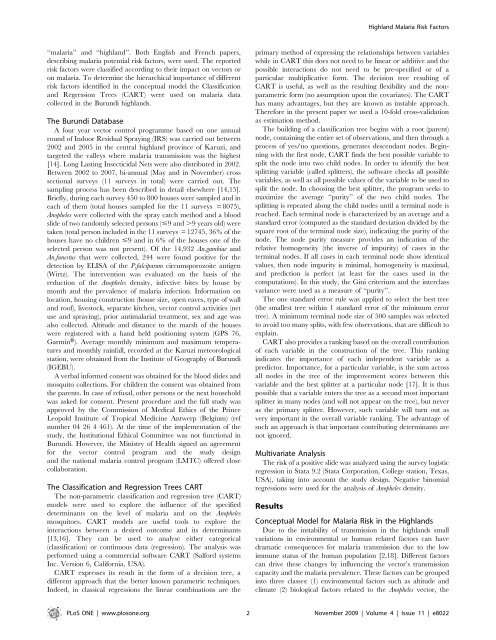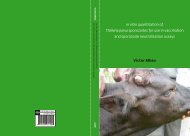Ranking malaria risk factors to guide malaria cont... - ResearchGate
Ranking malaria risk factors to guide malaria cont... - ResearchGate
Ranking malaria risk factors to guide malaria cont... - ResearchGate
Create successful ePaper yourself
Turn your PDF publications into a flip-book with our unique Google optimized e-Paper software.
Highland Malaria Risk Fac<strong>to</strong>rs<br />
‘‘<strong>malaria</strong>’’ and ‘‘highland’’. Both English and French papers,<br />
describing <strong>malaria</strong> potential <strong>risk</strong> <strong>fac<strong>to</strong>rs</strong>, were used. The reported<br />
<strong>risk</strong> <strong>fac<strong>to</strong>rs</strong> were classified according <strong>to</strong> their impact on vec<strong>to</strong>rs or<br />
on <strong>malaria</strong>. To determine the hierarchical importance of different<br />
<strong>risk</strong> <strong>fac<strong>to</strong>rs</strong> identified in the conceptual model the Classification<br />
and Regression Trees (CART) were used on <strong>malaria</strong> data<br />
collected in the Burundi highlands.<br />
The Burundi Database<br />
A four year vec<strong>to</strong>r <strong>cont</strong>rol programme based on one annual<br />
round of Indoor Residual Spraying (IRS) was carried out between<br />
2002 and 2005 in the central highland province of Karuzi, and<br />
targeted the valleys where <strong>malaria</strong> transmission was the highest<br />
[14]. Long Lasting Insecticidal Nets were also distributed in 2002.<br />
Between 2002 <strong>to</strong> 2007, bi-annual (May and in November) cross<br />
sectional surveys (11 surveys in <strong>to</strong>tal) were carried out. The<br />
sampling process has been described in detail elsewhere [14,15].<br />
Briefly, during each survey 450 <strong>to</strong> 800 houses were sampled and in<br />
each of them (<strong>to</strong>tal houses sampled for the 11 surveys = 8075),<br />
Anopheles were collected with the spray catch method and a blood<br />
slide of two randomly selected persons (#9 and .9 years old) were<br />
taken (<strong>to</strong>tal person included in the 11 surveys = 12745, 36% of the<br />
houses have no children #9 and in 6% of the houses one of the<br />
selected person was not present). Of the 14,932 An.gambiae and<br />
An.funestus that were collected, 244 were found positive for the<br />
detection by ELISA of the P.falciparum circumsporozoite antigen<br />
(Wirtz). The intervention was evaluated on the basis of the<br />
reduction of the Anopheles density, infective bites by house by<br />
month and the prevalence of <strong>malaria</strong> infection. Information on<br />
location, housing construction (house size, open eaves, type of wall<br />
and roof), lives<strong>to</strong>ck, separate kitchen, vec<strong>to</strong>r <strong>cont</strong>rol activities (net<br />
use and spraying), prior anti<strong>malaria</strong>l treatment, sex and age was<br />
also collected. Altitude and distance <strong>to</strong> the marsh of the houses<br />
were registered with a hand held positioning system (GPS 76,<br />
GarminH). Average monthly minimum and maximum temperatures<br />
and monthly rainfall, recorded at the Karuzi meteorological<br />
station, were obtained from the Institute of Geography of Burundi<br />
(IGEBU).<br />
A verbal informed consent was obtained for the blood slides and<br />
mosqui<strong>to</strong> collections. For children the consent was obtained from<br />
the parents. In case of refusal, other persons or the next household<br />
was asked for consent. Present procedure and the full study was<br />
approved by the Commission of Medical Ethics of the Prince<br />
Leopold Institute of Tropical Medicine Antwerp (Belgium) (ref<br />
number 04 26 4 461). At the time of the implementation of the<br />
study, the Institutional Ethical Committee was not functional in<br />
Burundi. However, the Ministry of Health signed an agreement<br />
for the vec<strong>to</strong>r <strong>cont</strong>rol program and the study design<br />
and the national <strong>malaria</strong> <strong>cont</strong>rol program (LMTC) offered close<br />
collaboration.<br />
The Classification and Regression Trees CART<br />
The non-parametric classification and regression tree (CART)<br />
models were used <strong>to</strong> explore the influence of the specified<br />
determinants on the level of <strong>malaria</strong> and on the Anopheles<br />
mosqui<strong>to</strong>es. CART models are useful <strong>to</strong>ols <strong>to</strong> explore the<br />
interactions between a desired outcome and its determinants<br />
[13,16]. They can be used <strong>to</strong> analyse either categorical<br />
(classification) or <strong>cont</strong>inuous data (regression). The analysis was<br />
performed using a commercial software CART (Salford systems<br />
Inc. Version 6, California, USA).<br />
CART expresses its result in the form of a decision tree, a<br />
different approach that the better known parametric techniques.<br />
Indeed, in classical regressions the linear combinations are the<br />
primary method of expressing the relationships between variables<br />
while in CART this does not need <strong>to</strong> be linear or additive and the<br />
possible interactions do not need <strong>to</strong> be pre-specified or of a<br />
particular multiplicative form. The decision tree resulting of<br />
CART is useful, as well as the resulting flexibility and the nonparametric<br />
form (no assumption upon the covariates). The CART<br />
has many advantages, but they are known as instable approach.<br />
Therefore in the present paper we used a 10-fold cross-validation<br />
as estimation method.<br />
The building of a classification tree begins with a root (parent)<br />
node, <strong>cont</strong>aining the entire set of observations, and then through a<br />
process of yes/no questions, generates descendant nodes. Beginning<br />
with the first node, CART finds the best possible variable <strong>to</strong><br />
split the node in<strong>to</strong> two child nodes. In order <strong>to</strong> identify the best<br />
splitting variable (called splitters), the software checks all possible<br />
variables, as well as all possible values of the variable <strong>to</strong> be used <strong>to</strong><br />
split the node. In choosing the best splitter, the program seeks <strong>to</strong><br />
maximize the average ‘‘purity’’ of the two child nodes. The<br />
splitting is repeated along the child nodes until a terminal node is<br />
reached. Each terminal node is characterized by an average and a<br />
standard error (computed as the standard deviation divided by the<br />
square root of the terminal node size), indicating the purity of the<br />
node. The node purity measure provides an indication of the<br />
relative homogeneity (the inverse of impurity) of cases in the<br />
terminal nodes. If all cases in each terminal node show identical<br />
values, then node impurity is minimal, homogeneity is maximal,<br />
and prediction is perfect (at least for the cases used in the<br />
computations). In this study, the Gini criterium and the interclass<br />
variance were used as a measure of ‘‘purity’’.<br />
The one standard error rule was applied <strong>to</strong> select the best tree<br />
(the smallest tree within 1 standard error of the minimum error<br />
tree). A minimum terminal node size of 500 samples was selected<br />
<strong>to</strong> avoid <strong>to</strong>o many splits, with few observations, that are difficult <strong>to</strong><br />
explain.<br />
CART also provides a ranking based on the overall <strong>cont</strong>ribution<br />
of each variable in the construction of the tree. This ranking<br />
indicates the importance of each independent variable as a<br />
predic<strong>to</strong>r. Importance, for a particular variable, is the sum across<br />
all nodes in the tree of the improvement scores between this<br />
variable and the best splitter at a particular node [17]. It is thus<br />
possible that a variable enters the tree as a second most important<br />
splitter in many nodes (and will not appear on the tree), but never<br />
as the primary splitter. However, such variable will turn out as<br />
very important in the overall variable ranking. The advantage of<br />
such an approach is that important <strong>cont</strong>ributing determinants are<br />
not ignored.<br />
Multivariate Analysis<br />
The <strong>risk</strong> of a positive slide was analyzed using the survey logistic<br />
regression in Stata 9.2 (Stata Corporation, College station, Texas,<br />
USA), taking in<strong>to</strong> account the study design. Negative binomial<br />
regressions were used for the analysis of Anopheles density.<br />
Results<br />
Conceptual Model for Malaria Risk in the Highlands<br />
Due <strong>to</strong> the instability of transmission in the highlands small<br />
variations in environmental or human related <strong>fac<strong>to</strong>rs</strong> can have<br />
dramatic consequences for <strong>malaria</strong> transmission due <strong>to</strong> the low<br />
immune status of the human population [2,18]. Different <strong>fac<strong>to</strong>rs</strong><br />
can drive these changes by influencing the vec<strong>to</strong>r’s transmission<br />
capacity and the <strong>malaria</strong> prevalence. These <strong>fac<strong>to</strong>rs</strong> can be grouped<br />
in<strong>to</strong> three classes: (1) environmental <strong>fac<strong>to</strong>rs</strong> such as altitude and<br />
climate (2) biological <strong>fac<strong>to</strong>rs</strong> related <strong>to</strong> the Anopheles vec<strong>to</strong>r, the<br />
PLoS ONE | www.plosone.org 2 November 2009 | Volume 4 | Issue 11 | e8022











